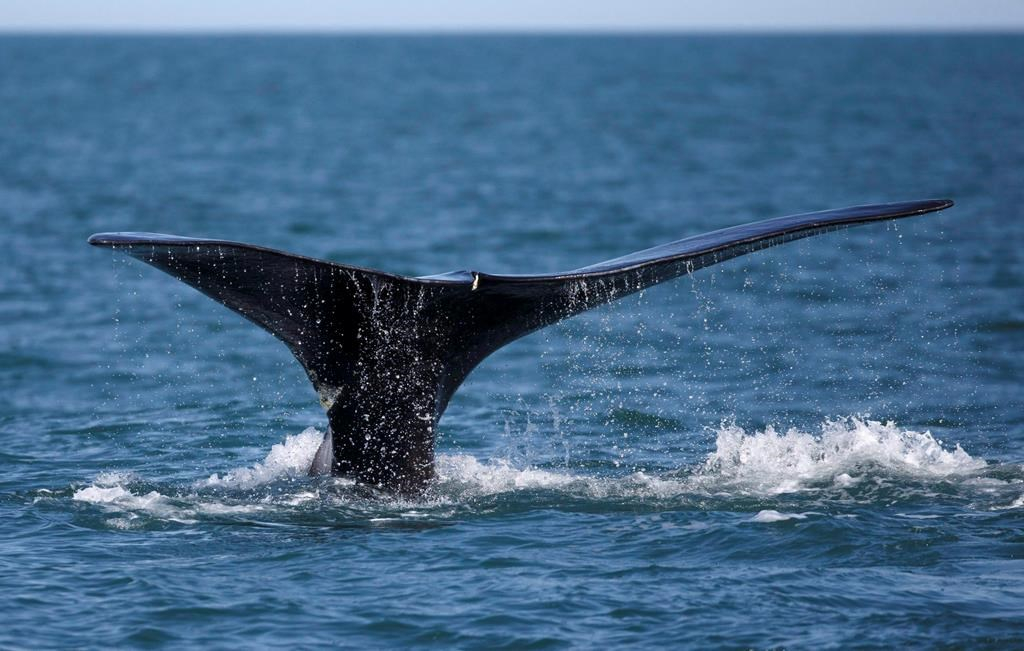Support strong Canadian climate journalism for 2025
Officials searching for an entangled North Atlantic right whale spotted in the Gulf of St. Lawrence hope to prevent it from succumbing to one of the leading causes of death for the endangered species.
In an emailed release, the Department of Fisheries and Oceans said the whale was seen swimming with a rope around its body off the coast of Miscou, N.B., and officers left Saturday to try to locate and help the animal.
The Fisheries Department said 12 North Atlantic right whales died unexpectedly in the Gulf of St. Lawrence between June and September of last year — two of them from entanglement in fishing gear, according to an incident report from the Canadian Wildlife Health Cooperative. Four others died from blunt trauma, likely caused by ship strikes.
A further five entanglements were also reported — two whales were freed by humans and two shed the gear on their own. The fate of the fifth whale is still unknown.
Jerry Conway, marine mammal advisor with the Canadian Whale Institute on Campobello Island, N.B., said that if the whale spotted Friday is found, the organization will dispatch their whale rescue team to help free it.
During such a rescue, the crew would head out in a boat and try to cut the animal free using an either an instrument that looks like a knife at the end of a pole, or a weighted rope with knives.
"It's a very sensitive operation, and you have to be aware of how the whales behave," Conway said in a phone interview Saturday. "These whales can be fairly aggressive and we have to monitor them closely before we actually go out and do the disentanglement operation."
The death of Joe Howlett, a lobster fisherman and a member of the Campobello Whale Rescue Team, highlighted the dangerous nature of such rescues, Conway said.
Howlett was killed a year ago in waters off eastern New Brunswick when he was struck by a whale just after freeing it from fishing gear. His death prompted a temporary ban on volunteer whale rescue efforts that was lifted in March.
Despite the dangers, Conway said disentangling the creatures is an important step in protecting the endangered right whale population, whose numbers have now dipped below 500.
"When the whales get entangled, it can ultimately lead to their demise. They can't feed, they can't swim," he said.
Several fishing areas in the Gulf of St. Lawrence are closed in an effort to mitigate whale deaths.
The closures "limit the potential for these whales to become entangled," said Conway, though he pointed out the whales are migratory and may pick up fishing gear from other places. "When we recover the gear, then we'll be able to determine where the entanglement occurred."
He added that anyone who sees an entangled whale should keep away and report it to the Fisheries Department.
While there have been no reported deaths of right whales this season thus far, the death toll appears to be rising for another whale species off the East Coast, raising concerns that the animals are falling victim to the same threats facing endangered North Atlantic right whales.
Last week, Tonya Wimmer of the Marine Animal Response Society said that since early February, about 14 minke whales have been found dead at sea or on beaches in the Maritimes, largely around northern New Brunswick. Others were found in the Bay of Fundy, off Cape Breton Island and off the eastern tip of P.E.I.
That's up from the average rate of about 10 deaths a year for minkes, a small whale species that is not considered at risk or threatened.
While many of the minke carcasses were too decomposed to determine a cause of death, Wimmer confirmed that several other animals found dead appear to have been killed by ship strikes or entanglements in fishing gear.





Comments